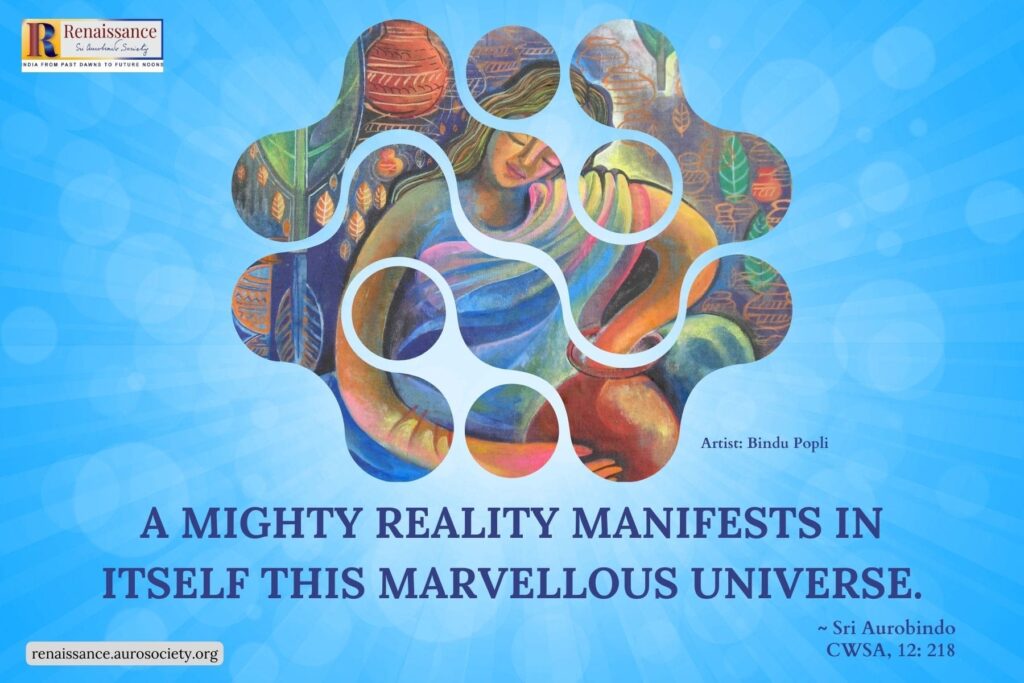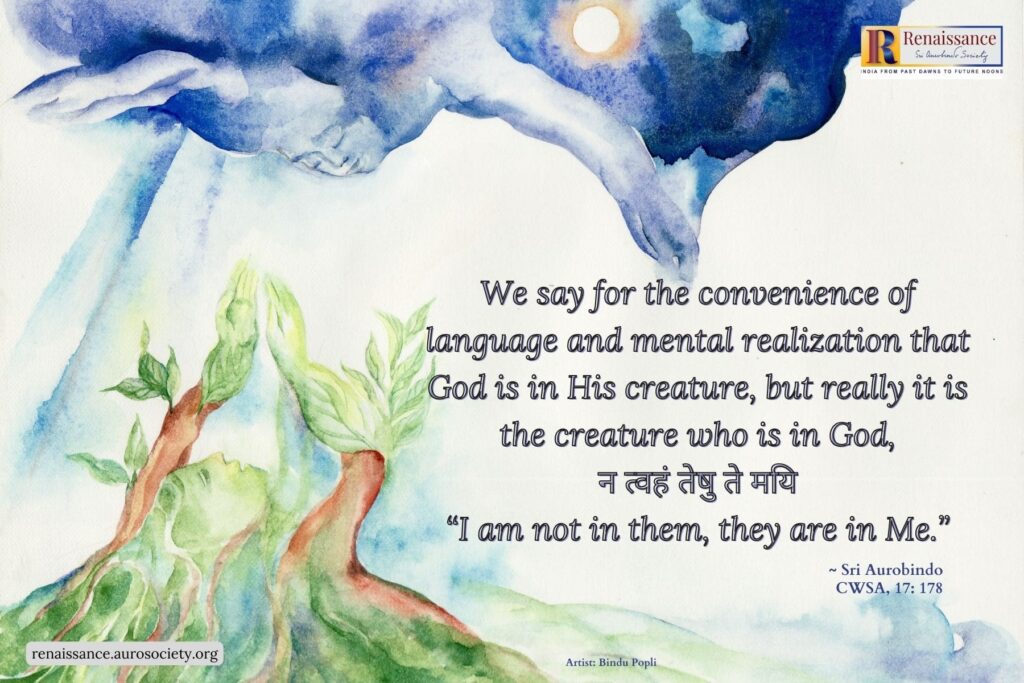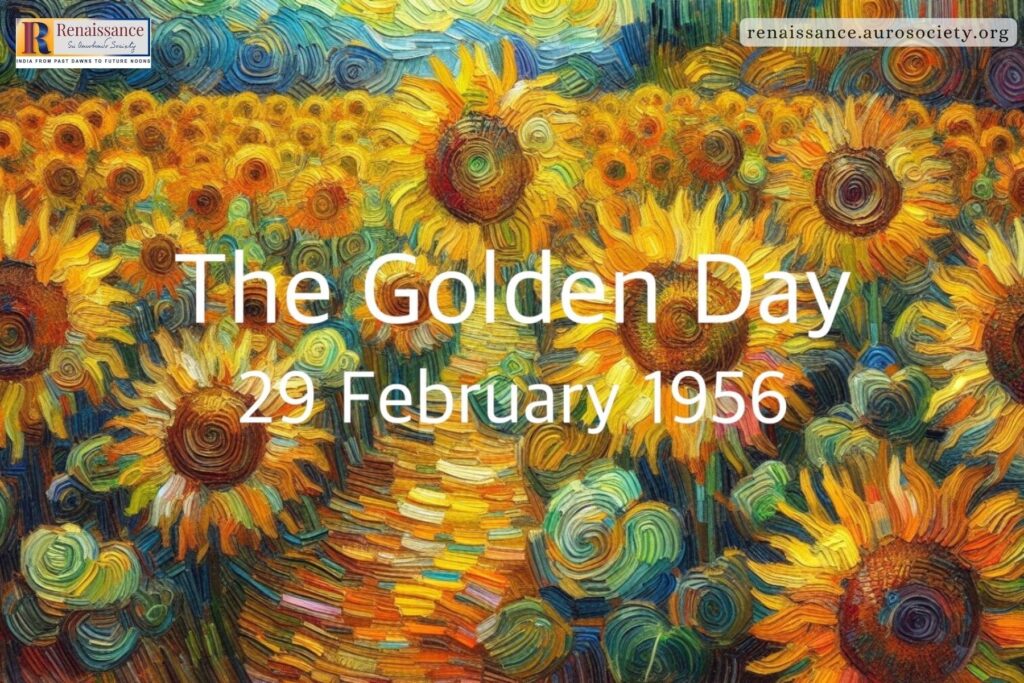Continued from Part 4
This is the thought-movement in the Upanishad so far.
The opening lines lay it down that this universe of movement is governed by the one inhabiting Spirit. The object of this manifestation is enjoyment and right living consisting in one’s full participation in this enjoyment which is truly possible only when there is an inner renunciation of Desire. This done, activity ceases to bind the doer who is one in soul with the Lord of All. Those who do not follow this rightful course of life not only miss enjoyment here on earth, but go to worlds of darkness after death.
The multiple Movement and the One Stability, are the same Brahman in different poises. Brahman the Reality, is both and beyond both. Man realises his unity with the rest of his fellow-beings only in proportion as he gains his identity with this cosmic and transcendental Self who is extended as and in all. In this unity are true harmony and happiness achieved displacing the elements of friction, grief, and illusion which are the results of a false sense of separativity born of ego.
Life is a manifestation of God. The universe is really an unfoldment of the Spirit.
“That divine Existence is the Lord who has gone abroad in the movement and unrolled the universe in His three modes as All-Seer of the Truth of things, Thinker-out of their possibilities, Realiser of their actualities. He has determined all things sovereignly in their own nature, development and goal from years sempiternal.”
(Sri Aurobindo, CWSA, Vol. 17, p. 63)
Vidya and Avidya, consciousness of the inherent unity and the consciousness of the phenomenal multiplicity, are twin powers of this Manifestation, each complementary—and not contradictory—to the other and when a right use is made of both. They carry the individual on their wings towards a supreme fulfilment. So also are Birth and Non-Birth; they are not opposite and irreconcilable. They are two states of the being, each necessary to the completeness of the other and a realisation of both the states is indispensable if the object of Manifestation, Immortality, is to be achieved.
To fulfil this aim, to arrive at this Goal of Beatitude with all the opulence of Knowledge, Power and Joy that go with it, the Upanishad invokes the aid of the Gods, the famed guardians of Immortality. It proceeds to call Surya, the God of Illumination and Agni, the Lord of divine Will and Action.
Verses 15 and 16
Verses 15 and 16 are invocation to Surya God.
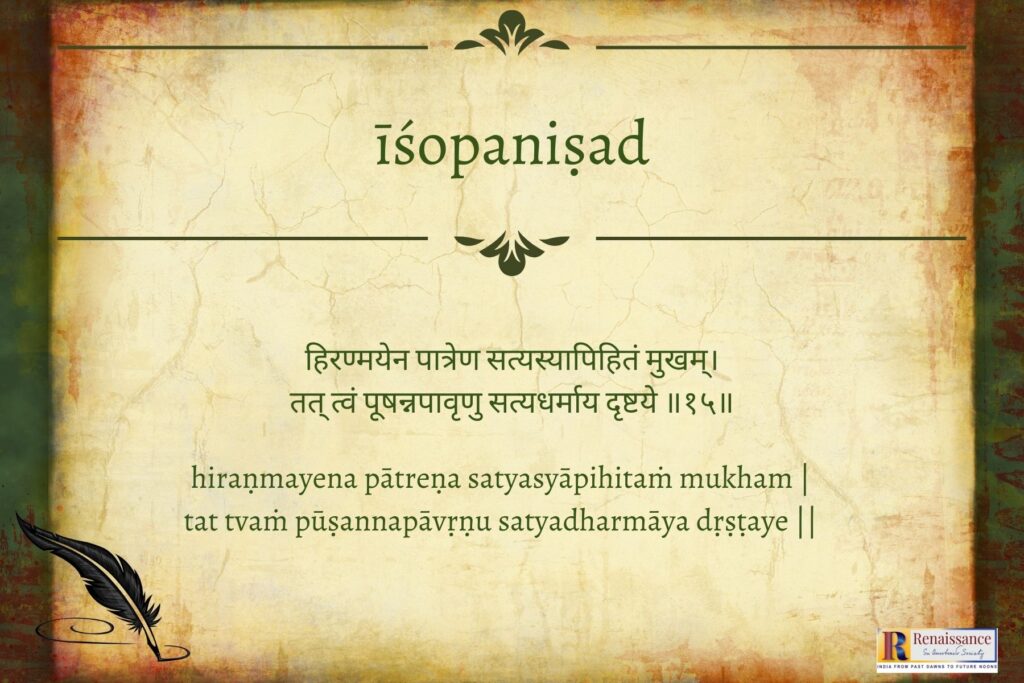
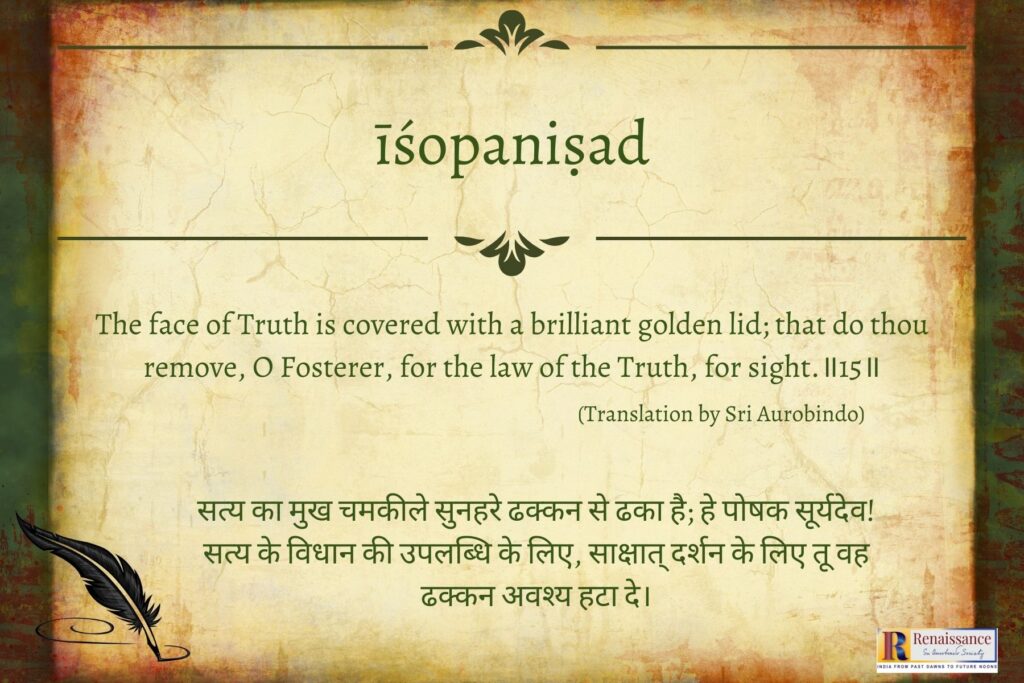
Sri Aurobindo explains the inner meaning of Surya, the Fosterer as realised by the Vedic rishis:
“In the inner sense of the Veda Surya, the Sun-God, represents the divine Illumination of the Kavi which exceeds mind and forms the pure self-luminous Truth of things. His principal power is self-revelatory knowledge, termed in the Veda “Sight”. His realm is described as the Truth, the Law, the Vast.
(CWSA, Vol. 17, p. 6)
“He is the Fosterer or Increaser, for he enlarges and opens man’s dark and limited being into a luminous and infinite consciousness.
“He is the sole Seer, Seer of Oneness and Knower of the Self, and leads him to the highest Sight.
“He is Yama, Controller or Ordainer, for he governs man’s action and manifested being by the direct Law of the Truth, satyadharma, and therefore by the right principle of our nature, yāthātathyataḥ.
“A luminous power proceeding from the Father of all existence, he reveals in himself the divine Purusha of whom all beings are the manifestations. His rays are the thoughts that proceed luminously from the Truth, the Vast, but become deflected and distorted, broken up and disordered in the reflecting and dividing principle, Mind. They form there the golden lid which covers the face of the Truth.
“The Seer prays to Surya to cast them into right order and relation and then draw them together into the unity of revealed truth. The result of this inner process is the perception of the oneness of all beings in the divine Soul of the Universe.”
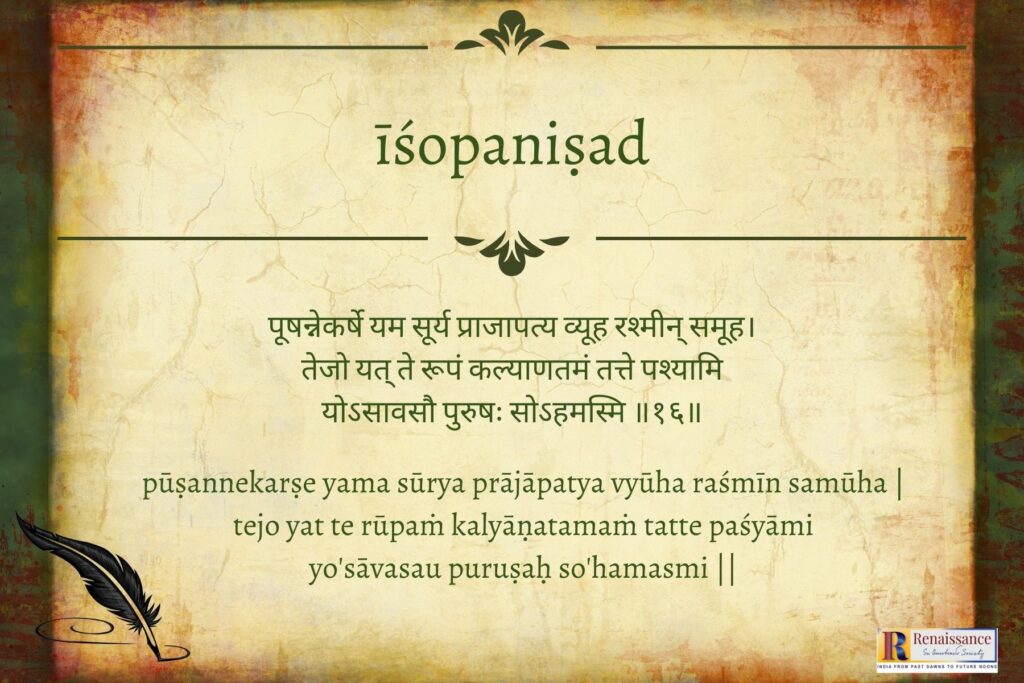
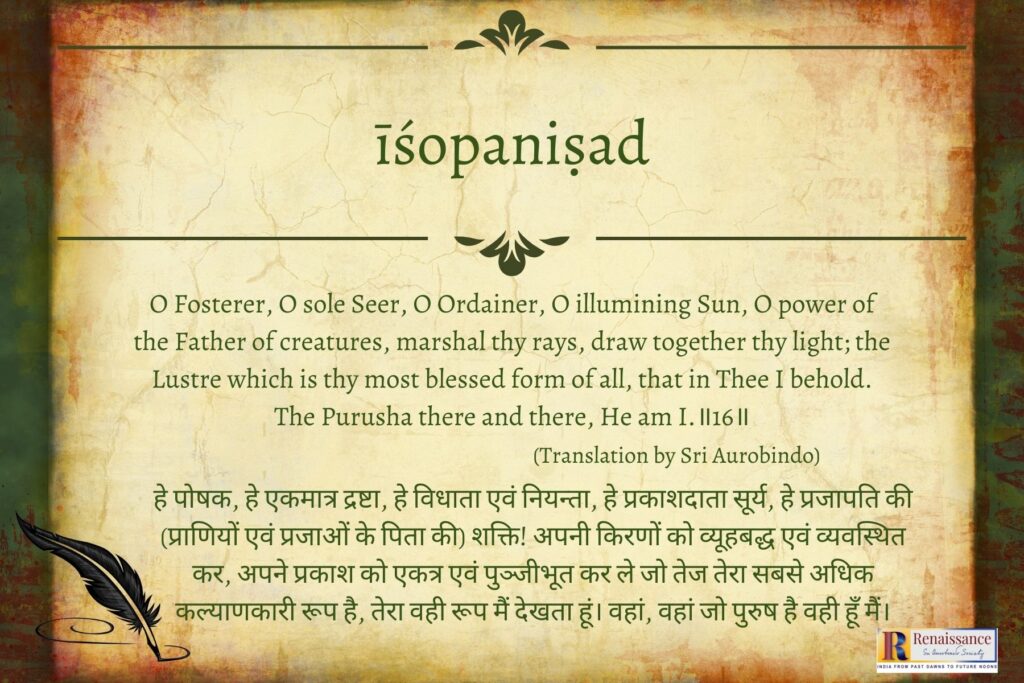
“Thus by the action of Surya we arrive at that light of the supreme superconscient in which even the intuitive knowledge of the truth of things based upon the total vision passes into the self-luminous self-vision of the one existent, one in all infinite complexities of a self-experience which never loses its unity or its self-luminousness. This is Surya’s goodliest form of all. For it is the supreme Light, the supreme Will, the supreme Delight of existence.
“This is the Lord, the Purusha, the self-conscient Being. When we have this vision, there is the integral self-knowledge, the perfect seeing, expressed in the great cry of the Upanishad, so’ham. The Purusha there and there, He am I. The Lord manifests Himself in the movements and inhabits many forms, but it is One who inhabits all. This self-conscient being, this real “I” whom the mental being individualised in the form is aware of as his true self—it is He. It is the All; and it is that which transcends the All.
(CWSA, Vol. 17, pp. 74-75)
This verse is one of the most typical in the Upanishadic literature bringing out the close relationship that exists between the Upanishads and the Veda. As noted earlier, the sages of the Upanishads always quote from the more ancient scripture in support, justification or in clinching a line of thought they develop. The present verse is not only an instance to the point but much more valuable for the transparency with which it enables one to see how the thought development has taken place, how the Upanishads make explicit what was implicit in the Veda. The orginal Rik Reads:
ऋतेन ऋतम् अपिहितं ध्रुवं वां सूर्यस्य यत्र विमुचन्त्य् अश्वान् |
दश शता सह तस्थुस् तद् एकं देवानां श्रेष्ठं वपुषाम् अपश्यम् || (RV.V.62.1)
ṛtena ṛtam apihitaṃ dhruvaṃ vāṃ sūryasya yatra vimucanty aśvān |
daśa śatā saha tasthus tad ekaṃ devānāṃ śreṣṭhaṃ vapuṣām apaśyam ||
“There is a Truth covered by a Truth where they unyoke the horses of the Sun;
the ten hundreds stood together, there was That One; I saw the greatest (best, most glorious) of the embodied gods.” (Translation by Sri Aurobindo)
Compare this with the two verses of the Isha under discussion. Drawing attention to this, Sri Aurobindo writes:
“. . . mark how the seer of the Upanishad translates this thought or this mystic experience into his own later style, keeping the central symbol of the Sun but without any secrecy in the sense. . . .
(CWSA, Vol. 16, p. 17)
The golden lid [in Isha Upanishad] is meant to be the same as the inferior covering truth, ṛtam, spoken of in the Vedic verse; the “best of the bodies of the Gods” is equivalent to the “fairest form of the Sun”, it is the supreme Light which is other and greater than all outer light; the great formula of the Upanishad, “He am I”, corresponds to That One, tad ekam, of the Rig Vedic verse; the “standing together of the ten hundreds” (the rays of the Sun, says Sayana, and that is evidently the meaning) is reproduced in the prayer to the Sun “to marshal and mass his rays” so that the supreme form may be seen.
The Sun in both the passages, as constantly in the Veda and frequently in the Upanishad, is the Godhead of the supreme Truth and Knowledge and his rays are the light emanating from that supreme Truth and Knowledge. It is clear from this instance—and there are others—that the seer of the Upanishad had a truer sense of the meaning of the ancient Veda than the mediaeval ritualistic commentator with his gigantic learning, much truer than the modern and very different mind of the European scholars.”
In his Commentary on the Rig Veda, Sri Kapali Sastry has gone into this interesting parallel in greater detail and has shown how close is the thought of the Upanishad to the spirit of the Vedic Mantra. He also points out other instances, e.g., RV. I. 25. 3 in the Samhita which contains the seeds of the perception that found its full unveiled expression in this verse of the Isha Upanishad.

To be continued…
Read previous parts: Part 1, Part 2, Part 3, Part 4
~ Graphic design: Biswajita Mohapatra

